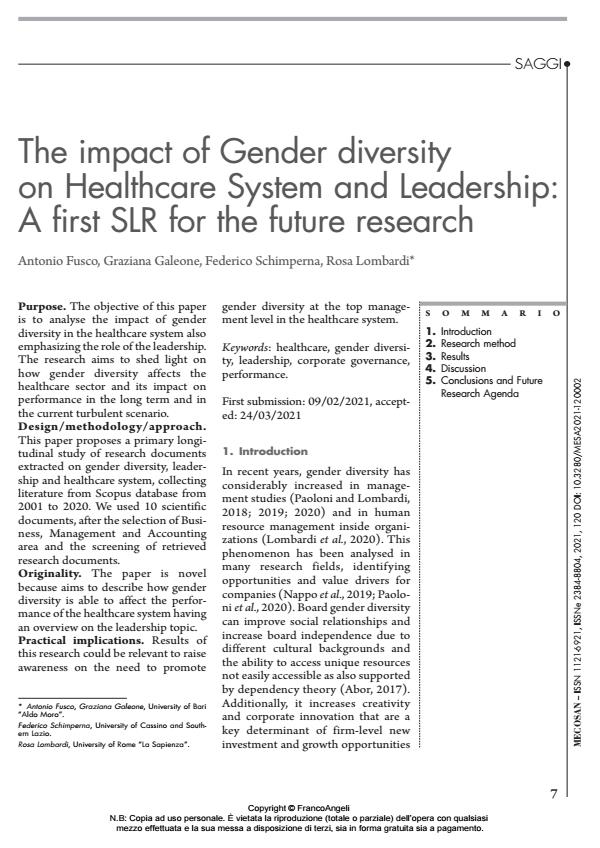The impact of Gender diversity on Healthcare System and Leadership: A first SLR for the future research
Titolo Rivista MECOSAN
Autori/Curatori Antonio Fusco, Graziana Galeone, Federico Schimperna, Rosa Lombardi
Anno di pubblicazione 2022 Fascicolo 2021/120
Lingua Inglese Numero pagine 13 P. 7-19 Dimensione file 329 KB
DOI 10.3280/MESA2021-120002
Il DOI è il codice a barre della proprietà intellettuale: per saperne di più
clicca qui
Qui sotto puoi vedere in anteprima la prima pagina di questo articolo.
Se questo articolo ti interessa, lo puoi acquistare (e scaricare in formato pdf) seguendo le facili indicazioni per acquistare il download credit. Acquista Download Credits per scaricare questo Articolo in formato PDF

FrancoAngeli è membro della Publishers International Linking Association, Inc (PILA)associazione indipendente e non profit per facilitare (attraverso i servizi tecnologici implementati da CrossRef.org) l’accesso degli studiosi ai contenuti digitali nelle pubblicazioni professionali e scientifiche
Purpose. The objective of this paper is to analyse the impact of gender diversity in the healthcare system also emphasizing the role of the leadership. The research aims to shed light on how gender diversity affects the healthcare sector and its impact on performance in the long term and in the current turbulent scenario. Design/methodology/approach. This paper proposes a primary longitudinal study of research documents extracted on gender diversity, leadership and healthcare system, collecting literature from Scopus database from 2001 to 2020. We used 10 scientific documents, after the selection of Business, Management and Accounting area and the screening of retrieved research documents. Originality. The paper is novel because aims to describe how gender diversity is able to affect the performance of the healthcare system having an overview on the leadership topic. Practical implications. Results of this research could be relevant to raise awareness on the need to promote gender diversity at the top management level in the healthcare system.
Parole chiave:healthcare, gender diversity, leadership, corporate governance, performance.
- Liderazgo Femenino en la Publicación Científica Alejandra Pando-Caciano, Katia Anahí Granados Guibovich, Peggy Carol Martinez Esteban , Emiliana Rizo-Patrón Terrero , Elizabeth Zulema Tomas-Gonzales, in Investigación e Innovación Clínica y Quirúrgica Pediátrica /2025
DOI: 10.59594/iicqp.2025.v3n1.144 - Gender diversity and healthcare performance: A quantitative analysis from the Italian health system D. Trinchese, M. Vainieri, P. Cantarelli, in Health Policy 105117/2024 pp.105117
DOI: 10.1016/j.healthpol.2024.105117
Antonio Fusco, Graziana Galeone, Federico Schimperna, Rosa Lombardi, The impact of Gender diversity on Healthcare System and Leadership: A first SLR for the future research in "MECOSAN" 120/2021, pp 7-19, DOI: 10.3280/MESA2021-120002